Related Research Articles
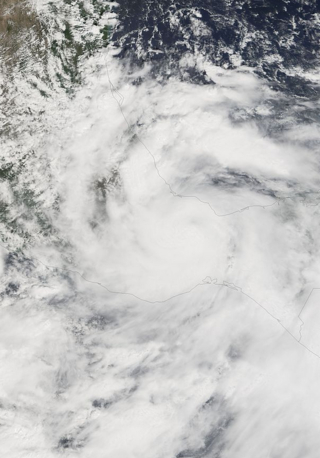
Hurricane Stan was the deadliest tropical cyclone of the 2005 Atlantic hurricane season. A relatively weak system that affected areas of Central America and Mexico in early October 2005, Stan was the eighteenth named storm and eleventh hurricane of the 2005 season, having formed from a tropical wave on October 1 after it had moved into the western Caribbean. The depression slowly intensified, and reached tropical storm intensity the following day, before subsequently making its first landfall on the Yucatán Peninsula. While traversing the peninsula, the tropical storm weakened, but was able to re-intensify once it entered the Bay of Campeche. Under favorable conditions for tropical development, Stan attained hurricane strength on October 4, and later reached peak intensity with winds of 80 mph (130 km/h) and a minimum barometric pressure of 977 mbar. The hurricane maintained this intensity until landfall near Punta Roca Partida, Mexico later the same day. Once over the mountainous terrain of Mexico, however, Stan quickly weakened, and dissipated on October 5.

Severe storms in Australia refers to the storms, including cyclones, which have caused severe damage in Australia. For comparison, a comprehensive list of all damaging storms can be found on the Australian Bureau of Meteorology website.
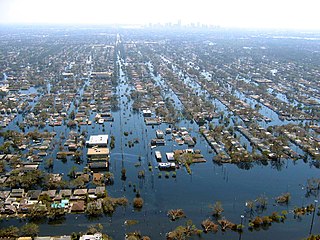
Floods in the United States (2000–present) is a list of flood events which were of significant impact to the country during the 21st century, since 2000. Floods are generally caused by excessive rainfall, excessive snowmelt, storm surge from hurricanes, and dam failure.
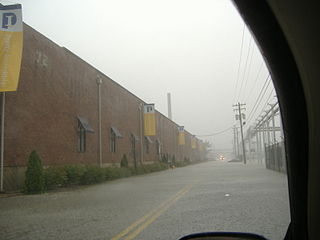
On August 4, 2009, at 9:25 am EDT a major thunderstorm producing large hail and winds in excess of 60 mph (97 km/h) advanced at the leading edge of a cold front moving across the American Midwest, causing a flash flood that struck Louisville and portions of the surrounding Kentuckiana region. The National Weather Service estimated that between three to six inches of rain fell across the city in less than one hour, breaking all previous one-hour rainfall records in the area. Most of the downtown area was underwater, with the deluge reaching four feet (1.2 m) deep in places. The flood was the third major disaster to strike the region in less than one year.
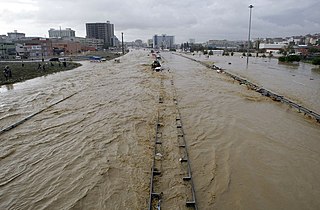
The 2009 Turkish flash floods were a series of flash floods that occurred on 9 September 2009 in and around Istanbul, Tekirdağ, and the rest of the Marmara Region of Turkey. The floods led to the death of at least 31 people and the cost of damage has been estimated as being in excess of $70 million.

The 2010 Madeira floods and mudslides were the result of an extreme weather event that affected Madeira Island in Portugal's autonomous Madeira archipelago on 20 February 2010. The flash flood killed 51 people, of whom 6 are still to be found, and injured 250. Around 600 people were left homeless.

The global weather activity of 2010 includes major meteorological events in the Earth's atmosphere during the year, including winter storms, hailstorms, out of season monsoon rain storms, extratropical cyclones, gales, microbursts, flooding, rainstorms, tropical cyclones, and other severe weather events.

In late May and early June 2016 flooding began after several days of heavy rain in Europe, mostly Germany and France, but also Austria, Belgium, Romania, Moldova, Netherlands and the United Kingdom. Among others, the German states of Bavaria, Hesse, Rhineland-Palatinate, Baden-Württemberg, and North Rhine-Westphalia were affected. Beginning at the river Neckar, the Danube, Rhine, Seine and their tributaries were highly affected by high water and flooding along their banks. At least 21 people died in the floods.

In June 2016, parts of the United Kingdom were struck by serious flash floods. Starting on 7 June, thunderstorms caused intense rainfall in many locations across the country, particularly in the north of England and in London, causing repeated flash floods in several locations on a daily basis.
The 2016 Johannesburg flood was a natural disaster in South Africa that took place on 9 November 2016. The flooding, which occurred in the area east of Johannesburg, affected both Johannesburg and Ekurhuleni. The storm and flash floods caused significant damage to the township of Alexandra, while the suburb of Buccleuch was declared a disaster area. The flooding was caused by a significant cloud burst from a convective system.
The Mocoa landslide was a natural disaster that took place in 2017. During the pre-dawn hours of 1 April 2017, locally heavy rain triggered flash flooding and landslides in the city of Mocoa, Putumayo, Colombia, killing at least 336 people, injuring 400, and leaving 200 others missing. It is the third-deadliest weather-related disaster in Colombian history, and is regarded as the worst catastrophe in the history of Mocoa.

Cyclone Numa, also known as Medicane Numa, was a Mediterranean tropical-like cyclone with the properties of a subtropical cyclone. Numa formed on 11 November 2017 west of the British Isles, out of the extratropical remnants of Tropical Storm Rina, the seventeenth named storm of the 2017 Atlantic hurricane season. Subsequently, on 17 November, Numa acquired subtropical characteristics before reaching peak intensity on 18 November, becoming a rare "medicane". After making landfall in Greece on 18 November, Numa rapidly weakened, and was later absorbed into another extratropical storm on 20 November. The flooding triggered by Numa became the worst weather event Greece had experienced since 1977, and the storm caused an estimated $100 million in damages in Europe.

In late June through mid-July 2018, successive heavy downpours in southwestern Japan resulted in widespread, devastating floods and mudflows. The event is officially referred to as Heisei san-jū-nen shichi-gatsu gōu by the Japan Meteorological Agency. As of 20 July, 225 people were confirmed dead across 15 prefectures with a further 13 people reported missing. More than 8 million people were advised or urged to evacuate across 23 prefectures. It is the deadliest freshwater flood-related disaster in the country since the 1982 Nagasaki flood when 299 people died.

Hispaniola is an island in the Caribbean, with the second largest size throughout all of the Caribbean. Throughout the centuries, since reliable records began, hundreds of hurricanes and tropical cyclones have affected Haiti and the Dominican Republic, the two countries that share the island. The most recent tropical cyclone to affect Hispaniola was Hurricane Fiona in September 2022.

Honduras, officially the Republic of Honduras, is a country in Central America. To the north of Honduras is Guatemala and Belize, to the south is Nicaragua, to the west is El Salvador, and to the east is the Caribbean Sea.

The following is a list of weather events that occurred in 2021. The year began with La Niña conditions. There were several natural disasters around the world from various types of weather, including blizzards, cold waves, droughts, heat waves, tornadoes, and tropical cyclones. In December, powerful Typhoon Rai moved through the southern Philippines, killing 410 people and becoming the deadliest single weather event of the year. The costliest event of the year, and the costliest natural disaster on record in the United States, was from a North American cold wave in February 2021, which caused $196.4 billion (USD) in damage; the freezing temperatures and widespread power outages in Texas killed hundreds of people. Another significant natural disaster was Hurricane Ida, which struck southeastern Louisiana and later flooded the Northeastern United States, resulting in $70 billion (USD) in damage. December saw two record-breaking tornado outbreaks, only four days apart from each other. In Europe, the European Severe Storms Laboratory documented 1,482 weather-related injuries and 568 weather-related fatalities. The National Oceanic and Atmospheric Administration documented 796 weather-related fatalities and at least 1,327 weather-related injuries in the United States and the territories of the United States.

In July 2021, several European countries were affected by severe floods. Some were catastrophic, causing deaths and widespread damage. The floods started in the United Kingdom as flash floods causing some property damage and inconvenience. Later floods affected several river basins across Europe including Austria, Belgium, Croatia, Germany, Italy, Luxembourg, the Netherlands, and Switzerland. At least 243 people died in the floods, including 196 in Germany, 43 in Belgium, two in Romania, one in Italy and one in Austria.
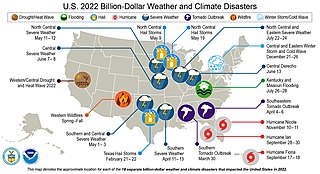
The following is a list of weather events that occurred on Earth in the year 2022. The year began with a La Niña. The most common weather events to have a significant impact are blizzards, cold waves, droughts, heat waves, wildfires, floods, tornadoes, and tropical cyclones. The deadliest weather event of the year was the European heat waves, which killed over 26,000 people, 11,000 of which in France. The costliest weather event of the year was Hurricane Ian, which caused at least $112.9 billion in damages in Florida and Cuba. Another significant weather event was the Pakistan floods, which killed 1,739 people and a total of $14.9 billion in damages.

Throughout 2022, floods affected most of Africa, killing over 2,100 people. The worst affected country was Nigeria, with over 610 deaths.
References
- 1 2 3 4 Macedonia storm: Deadly freak floods hit Skopje, BBC, 7 August 2016.
- 1 2 3 4 5 Macedonia declares state of emergency after 21 die in flash floods, Reuters , 7 August 2016.
- ↑ At least 20 dead as storms, flash floods lash Skopje in Macedonia, ABC News Australia , 7 August 2016.